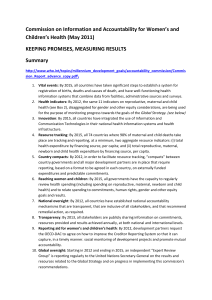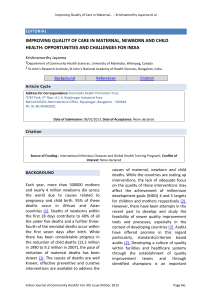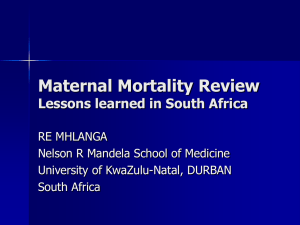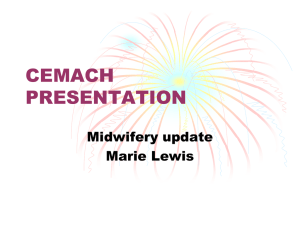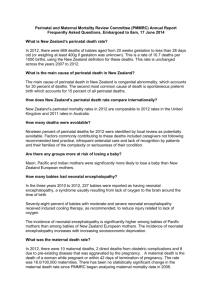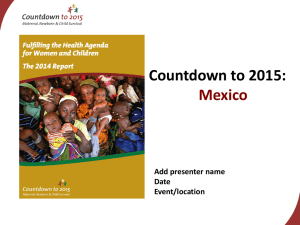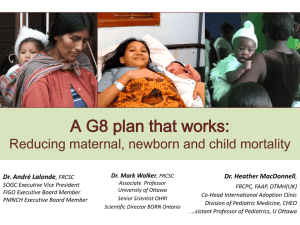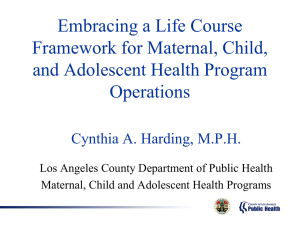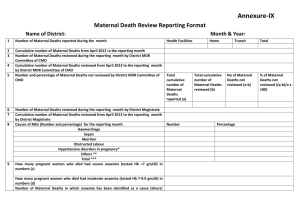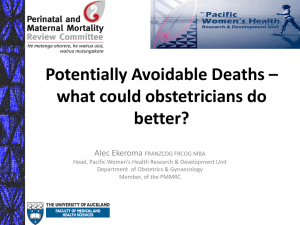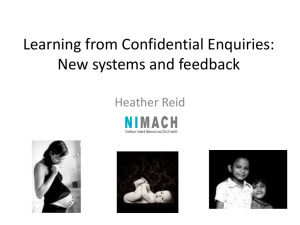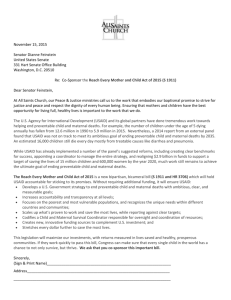see Powerpoint presentation
advertisement
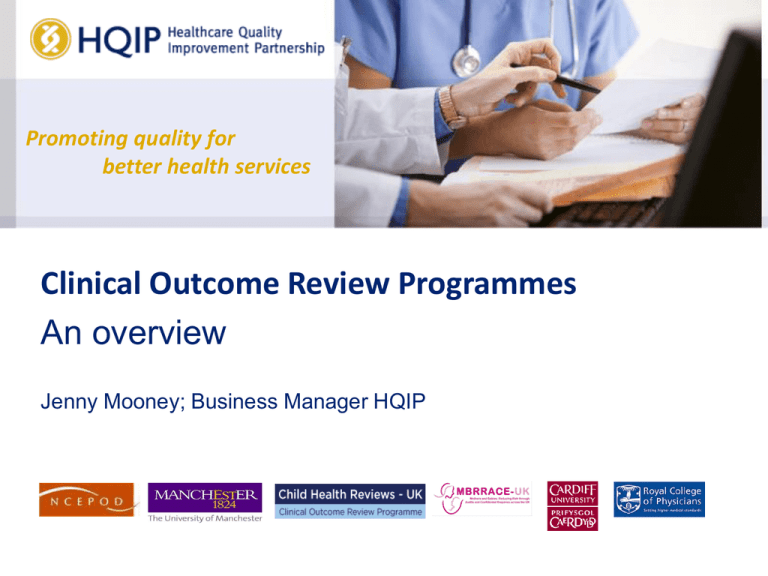
Promoting quality for better health services Clinical Outcome Review Programmes An overview Jenny Mooney; Business Manager HQIP Current Suppliers A. Child Health Programme ~ CHR-UK, Child Health Reviews-UK, Royal College of Paediatrics and Child Health B. Maternal, Newborn and Infant Programme ~ MBRRACE-UK, National Perinatal Epidemiology Unit, University of Oxford. C. Medical & Surgical Programme ~ NCEPOD (National Confidential Enquiry for Patient Outcome & Death) D. Mental Health Programme ~ NCISH, (National Confidential Inquiry into Suicide and Homicide by Patients with Mental Illness) University of Manchester E. *National Review of Asthma Deaths~ NRAD ~ Royal College of Physicians F. *Child Head Injury Project ~ University of Cardiff Clinical Outcome Review Programmes Confidential Case Note Review Surveillance Linkage of Administrative Data Use of Primary Care Data Themed reviews using serious morbidity and mortality data Patient Stories A. Child Health Programme Part 1: Institute of Child Health, UCL • A national, retrospective, epidemiological overview of deaths in children aged 118, using existing data sets. • Linking ONS death certification data with HES admission data. • Trends in what children die with (not die of) • Are there important groups in contact with healthcare in whom anticipatory/preventive management might reduce risk of death? Child death Birth Preterm Birth asphyxia Injury – cause undetermined Aspiration pneumonia Cerebral palsy Head injury A. Child Health Programme Part 2: RCPCH • Around 1 in 200 children in the UK has a form of epilepsy. • 40 to 80 children a year die as a result. • 59% avoidable factors in 2002 • Case reviews of children and young people with epilepsy who die or suffer severe morbidity. • The review will extend across the entire care pathway including primary and emergency care. B. Maternal, Newborn and Infant Programme • Surveillance of all maternal deaths and deaths of babies from 24 weeks to 1 Year (28 days currently) • Case review of all maternal deaths , including thematic review of cases where women and their babies survive serious illness. • Topic based maternal and perinatal reports Maternal Sepsis Congenital Diaphragmatic Hernia Maternal Mortality Pulmonary Embolism UK 1985-2008 3.5 Rate per 100,000 maternities 3 2.5 2 1.5 1 0.5 0 1985-87 1988-90 1991-93 1994-96 1997-99 Year 2000-02 2003-05 2006-08 B. Maternal, Newborn and Infant Programme ….more to be done • (2009) 4,100 stillbirths /11 per day, one of the highest rates across all high income countries. • If you add newborn deaths to the above figure this rate increases to 17 per day • Up to 100 women die annually during or just after pregnancy. C. Medical and Surgical Programme Study aim To describe variability and identify remediable factors in the process of care of adult patients who receive resuscitation in an in-hospital setting (526 cases) Appreciation of situation • Almost 1 in 5 cases were not appreciated • A safety concern – An obstacle to rapid intervention / escalation • A function of seniority? Appreciation of situation Escalation • 1 in 5 • Delays and safety concerns Impact of consultant review • Changes in 6/10 cases CPR status • CPR status recorded in 44 patients only (10%) • Remember population – Age, comorbidity, functional status, acute disease Case study Recommendations • Improved recognition and escalation • Consultant review within 12 hours • CPR status must be considered and recorded for all acute admissions. – Decisions not to resuscitate should not affect the provision of active treatment – The use of ‘ceilings of care’ documentation would facilitate decision making and clarity of intent. There is need for a national project to lead this work. C. NCEPOD Projects coming up To explore remediable factors in the process of care of patients admitted with the diagnosis of subarachnoid haemorrhage, looking both at patients that underwent an interventional procedure and those managed conservatively. Remediable factors in the quality of care provided to patients treated for alcohol-related liver disease and the degree to which its mortality is amenable to health care intervention. Tracheostomy related complications during and following critical care. Remedial factors in the processes of care of patients who die following lower limb amputation. D. Mental Health Programme The Centre for Mental Health and Risk In-patient suicides (England) In-patient suicide Hanging/strangulation on the ward Projected 250 214 191 200 188 196 183 179 Frequency 165 162 155 150 138 118 94 100 91 75 54 43 50 51 41 40 46 36 34 28 30 19 15 22 18 0 1997 1998 1999 2000 2001 2002 2003 2004 2005 2006 2007 2008 Year Source: National Confidential Inquiry into Suicide and Homicide by People with Mental Illness 2009 The Centre for Mental Health and Risk Key service recommendations •Removal of ligature points •Assertive outreach •24-hour crisis team •7-day follow-up •Multi-disciplinary review •Training in suicide risk management Safety First, 2001 12 Steps to a Safer Service The Centre for Mental Health and Risk Do safety measures reduce suicide rates? Recommendation Target group Ligature points In-patients 24% Assertive outreach ‘Non-compliant’ community patients 32% ‘Missed appointment’ community patients 11% 24-hour crisis team In-patients 29% 7-day follow-up Patients within 3 months of discharge 21% ‘Non-compliant’ community patients 25% Assertive outreach Non-compliance policy Source: National Confidential Inquiry, Lancet, 2012 % fall in suicide D. Mental Health Programme: Topics • Quality of risk assessment prior to fatal outcome • Models of Care Delivery • A population based investigation of suicide by patients in contact with primary care E. National Review of Asthma Deaths • To improve the understanding of why people die from asthma in order that deaths can be prevented in the future • Numbers less than anticipated. • 102 cases have gone to panel. • Family interviews • Reports April 2014 F. Child Head Injury Project • • • Traumatic head injury is amongst the most common cause of morbidity, mortality, disability and lost years of productive life in children. In 2009 CMACE collected data on approximately 6000 children who attended hospital with head injury Analysis by Cardiff aims to provide; A description of the mechanism of head injury to identify measures for prevention Analysis of pre hospital care data An assessment of clinical decision making on the selection of head-injured infants for CT scanning and compliance with NICE guidance on the early management of head injury in infants and children. Head injury outcomes according to service provision, times to transfer and units involved. A review of data relating to children who have suffered abusive head trauma. Moving on...... • Translating recommendations into improved outcomes. • Vignettes of ‘what good looks like’. • Electronic notification portals/Direct data entry systems • Audit tool kits/self assessment (NCEPOD/NCISH) • Linking to improvement programmes Getting Involved • • • • Use NCEPOD/NCISH audit toolkits Nominate a topic Local co ordinators/Ambassators Quality Accounts Contact us Healthcare Quality Improvement Partnership 4 Bury Street London EC3A 5AW www.hqip.org.uk jenny.mooney@hqip.org.uk Promoting quality improvement for better healthcare

